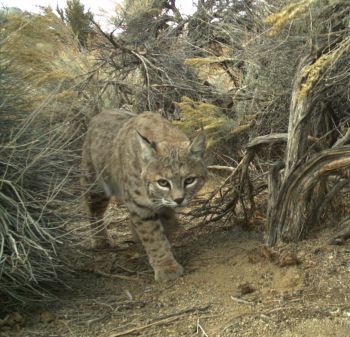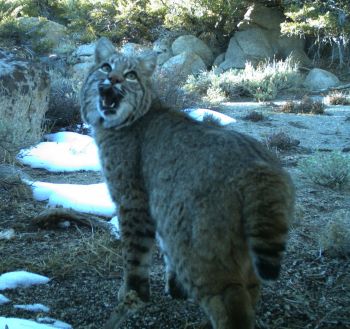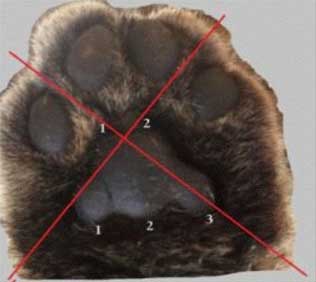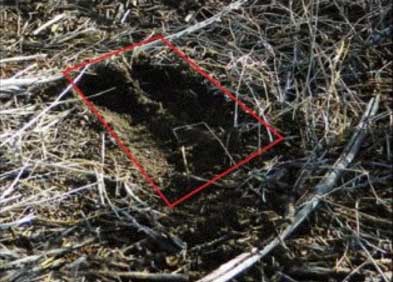Natural History
Bobcats (Lynx rufus) play an important role in maintaining healthy ecosystem function by controlling prey populations. Bobcats are a common species that can be found throughout California from the high alpine zones to thick forests and arid deserts. Bobcats prefer environments that include dense vegetative cover or steep rocky terrain. These areas provide protection from competing species such as mountain lions, coyotes, and birds of prey. Rocky terrain and vegetated areas attract a bobcat’s main prey species (rabbits and rodents). Bobcats in the inland Deserts Region (IDR) have also been documented preying on upland birds, mule deer, and bighorn sheep. Learn more about the natural history of the bobcat:
Management Projects and Reports
 Photo 11/15; J. Fusaro camera trap.
Photo 11/15; J. Fusaro camera trap.
 Photo 11/15; J. Fusaro camera trap.
Photo 11/15; J. Fusaro camera trap.
Bobcats are a common species in North America with stable or increasing populations. Florida is the only state that reports a declining population, which is attributed to the increase in invasive Burmese pythons (Python molurus bivittatus). Bobcats are listed by the International Union for Conservation of Nature as a species of least concern and the national population estimate is between 2.3 - 3.5 million. The harvest data and observations that IDR biologists have collected on bobcats supports the assumption that bobcat populations in Inyo and Mono Counties are robust and healthy. However, with the onset of the Bobcat Protection Act (AB-1213), biologists in the IDR identified the importance of obtaining data to provide additional information regarding the status of bobcats.
In 2014, the Inland Desert Region Wildlife Program acquired funding from the federal Wildlife and Sport Fish Restoration Program supported by Pittman-Robertson funds to begin a study on bobcats in the eastern Sierra Nevada and Owens Valley. The goal of the study was to elucidate the health and ecology of bobcats in the IDR. The main objectives for this study were to standardize survey techniques and GPS-collar bobcats to allow for population monitoring. Detailed reports are provided below:
Preventing Conflicts
CDFW stresses that aggressive behavior by bobcats toward humans is extremely rare. Most bobcats are elusive in nature and rarely seen. CDFW urges residents to take all reasonable actions to secure their domestic pets and any potential attractants to reduce conflict with bobcats and other wildlife. See Tips on preventing bobcat conflicts.
Viewing Bobcats
Bobcat populations in Inyo and Mono Counties are healthy, but it is uncommon to see a bobcat in the wild. Just because you do not see bobcats in an area does not mean they are not around. Bobcats are elusive animals that typically avoid humans. Bobcats are considered crepuscular or active primarily after dawn and immediately before dusk. They spend most of their daytime hours hidden from view while trying to stay cool and napping. The most common way to identify whether bobcats are in the area is through bobcat sign such as tracks or scat. Here are some tips to help you recognize bobcat sign:
 Figure 1. A bobcat paw showing the lobe pattern of the heel and how a diagonal line drawn between the outer and inner toes will intersect the heel pad.
Figure 1. A bobcat paw showing the lobe pattern of the heel and how a diagonal line drawn between the outer and inner toes will intersect the heel pad.
 Figure 2. A bobcat scrape is typically 6-10 in. long. The cats make these scrapes with their hind paws. The Inland Desert Region biologists find these scrapes near caches, prime hunting areas, and territory boundaries.
Figure 2. A bobcat scrape is typically 6-10 in. long. The cats make these scrapes with their hind paws. The Inland Desert Region biologists find these scrapes near caches, prime hunting areas, and territory boundaries.
Tracks
Bobcat tracks are usually double the size of a house cat's and half the size of a mountain lion’s, averaging 2-2 ½ in. across. All cats have four toes. You do not typically see claw marks because a bobcat’s claws are retractable and remain in the paw while walking. The front of the heel pad has 2 lobes and the rear of the heel pad has 3 lobes. Unlike a canine track, you cannot draw a straight, diagonal line between the outer and inner toes to the opposite corner of the track without intersecting the heel pad (Figure 1). Great places to find good bobcat tracks in the IDR are sandy dry creek beds. You may also find a bobcat scrape, which occurs when they use their hind paws to dig a small depression in the soil (Figure 2). Scrapes are typically uniform in shape and about 6-10 in. long. Bobcats will often urinate in the scrape. Biologists believe these scrapes are used to mark territory and the pheromones in the urine will advertise breeding status.
Hunting
Commercial and recreational trapping of bobcats was prohibited statewide November 20, 2015. Hunting was prohibited beginning January 1, 2020. Check the Non-game and Furbearer Hunting page for more information about current hunting regulations.
Lead CDFW biologists: Shannon Forshee
787 North Main St. Suite 220, Bishop, CA 93514
Shannon.Forshee@wildlife.ca.gov
Books
- Grinnell, J., J. S. Dixon, and J. M. Linsdale. 1937. Fur-bearing mammals of California: Their natural history systematic status and relations to man. 1st Edition. Volume 2. University of California Press, Berkeley, California, U.S.A.
- Laws, J. M. 2007. The laws field guide to the Sierra Nevada. California Academy of Sciences. Heyday Books, Berkeley, California, U.S.A.
Internet Resources
Literature / Reports
- Ellsworth, A, M. Brown, J. Fusaro, A. Johnson, A. Stewart, B. Nolan, G. Taylor and V. Davis. Eastern Sierra Nevada Mesocarnivore Annual Report 2017 (Ellsworth et al.) (PDF).
- Ellsworth, A, J. Fusaro, A. Johnson, D. Clifford, M. Brown, A. Stewart, and V. Davis Eastern Sierra Nevada Bobcat Study Annual Report 2016 (PDF). California Department of Fish and Wildlife. California Department of Fish and Wildlife; 8/2016.
- Roberts NM, Crimmins SM. 2010. Bobcat population status and management in North America: evidence of large-scale population increase (PDF). Journal of Fish and Wildlife Management 1(2):169–174; e1944-687X. doi: 10.3996/122009-JFWM-026.
- Zezulak, D. S. 1981. Northeastern California bobcat study (PDF). California Dept. Fish Game Rep. Fed. Aid Wildl. Rest. Proj 19. W-54-R-12, job IV-3.
- Zezulak, D. S. and R. G. Schwab. 1980. Bobcat biology in a Mojave desert community. California Dept. Fish Game Rep. Fed. Aid Wildl. Rest. Proj W-54-R-12, job IV-4.